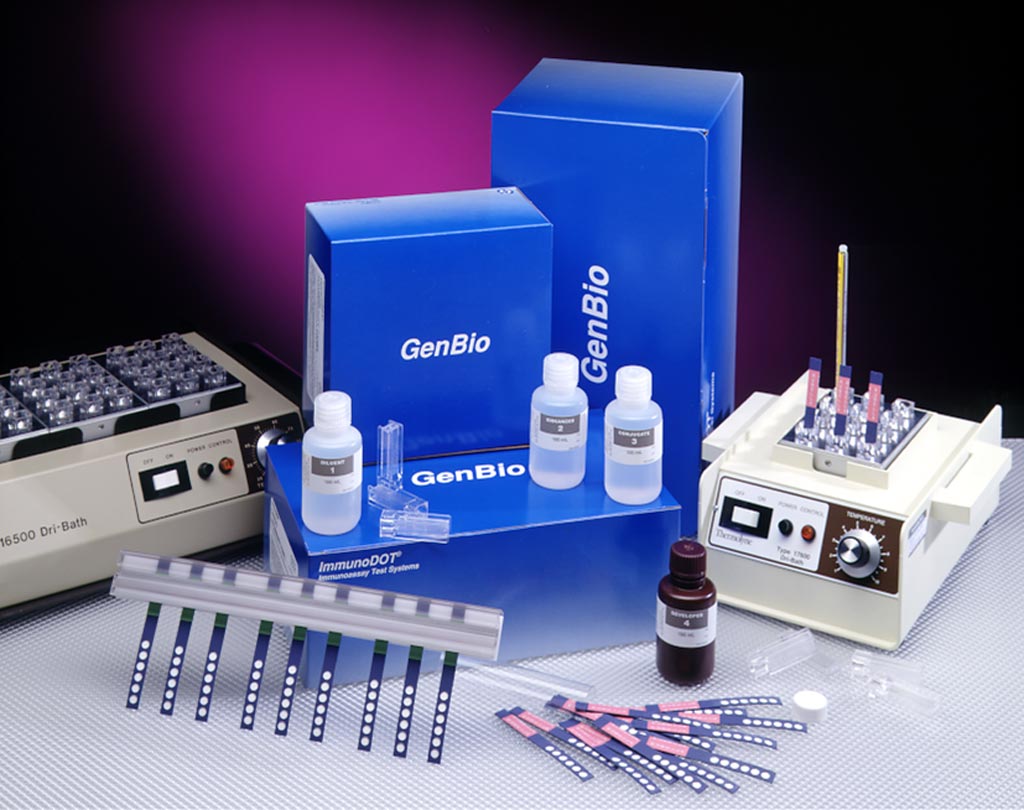Assays Evaluated for Early Diagnosis of Leptospirosis
|
By LabMedica International staff writers Posted on 11 Jul 2017 |

Image: The ImmunoDOT is a proprietary dotblot method reporting a semi-quantitative IgM titer for leptospirosis (Photo courtesy of GenBio).
Leptospirosis is a potentially life-threatening but curable zoonosis whose prognosis depends on accurate and timely diagnosis and because of its non-specific clinical presentation, laboratory testing is essential to confirm the diagnosis.
Leptospirosis is caused by pathogenic spirochetes of the genus Leptospira. With an estimated 1.03 million cases and 58,900 deaths occurring each year, leptospirosis represents a major threat to public health worldwide. Severity ranges from relatively mild flu-like symptoms to Weil’s syndrome, a severe and potentially life-threatening form of the disease characterized by multiple organ failure, including the liver, kidneys, lungs, heart and brain.
Microbiologists at the University Hospital of Fort-de-France (Martinique, French West Indies) and their colleagues conducted a retrospective study between January 2011 and December 2012 of a total of 122 patients were diagnosed with leptospirosis, as confirmed by quantitative polymerase chain reaction (qPCR). Among them, 103 had at least one serum sample available for analysis. Performance of each serological assay was evaluated according to days' post onset of symptoms (DPO) and local species diversity.
Blood plasma samples were collected in ethylenediaminetetraacetic acid (EDTA) tubes obtained from patients with clinically suspected leptospirosis. Serum specimens were collected in plastic red-top tubes at different times during the course of the illness and stored at -20 °C until testing. The team assessed the performance of two enzyme-linked immunosorbent assays (ELISAs): ELISA Serion and ELISA-Hb Pasteur and one immunodot using qPCR as the gold standard.
The scientists reported the sensitivity of ELISA Serion, ELISA-Hb Pasteur and GenBio immunodot was 75%, 67% and 64%, while specificity was 92%, 98% and 100%, respectively. Moreover, the threshold optimization allowed a significant improvement in specificity for the ELISA Serion from 92% to 99%. During the first five DPO, sensitivities were 35%, 30% and 42% for ELISA Serion, ELISA-Hb Pasteur and GenBio immunodot, respectively. However, between six to 10 DPO, these sensitivities dramatically increased to reach 86%, 76% and 67%, respectively. Performances of the three assays were not affected by the species studied.
The authors concluded that all the serological assays evaluated showed the potential for diagnosing leptospirosis after, but not before six days’ post onset of symptoms. In a high prevalence setting, where highest specificities are needed, threshold optimizing should be performed for this purpose. The combination of serology and qPCR could be the most reliable approach for laboratory confirmation of clinically suspected cases of leptospirosis in resource-limited settings, easy handling and cost-effectiveness may be the main decision factors to choose between assays with similar accuracy for routine use. The study was published on June 23, 2017, in the journal Public Library of Science Neglected Tropical Diseases.
Related Links:
University Hospital of Fort-de-France
Leptospirosis is caused by pathogenic spirochetes of the genus Leptospira. With an estimated 1.03 million cases and 58,900 deaths occurring each year, leptospirosis represents a major threat to public health worldwide. Severity ranges from relatively mild flu-like symptoms to Weil’s syndrome, a severe and potentially life-threatening form of the disease characterized by multiple organ failure, including the liver, kidneys, lungs, heart and brain.
Microbiologists at the University Hospital of Fort-de-France (Martinique, French West Indies) and their colleagues conducted a retrospective study between January 2011 and December 2012 of a total of 122 patients were diagnosed with leptospirosis, as confirmed by quantitative polymerase chain reaction (qPCR). Among them, 103 had at least one serum sample available for analysis. Performance of each serological assay was evaluated according to days' post onset of symptoms (DPO) and local species diversity.
Blood plasma samples were collected in ethylenediaminetetraacetic acid (EDTA) tubes obtained from patients with clinically suspected leptospirosis. Serum specimens were collected in plastic red-top tubes at different times during the course of the illness and stored at -20 °C until testing. The team assessed the performance of two enzyme-linked immunosorbent assays (ELISAs): ELISA Serion and ELISA-Hb Pasteur and one immunodot using qPCR as the gold standard.
The scientists reported the sensitivity of ELISA Serion, ELISA-Hb Pasteur and GenBio immunodot was 75%, 67% and 64%, while specificity was 92%, 98% and 100%, respectively. Moreover, the threshold optimization allowed a significant improvement in specificity for the ELISA Serion from 92% to 99%. During the first five DPO, sensitivities were 35%, 30% and 42% for ELISA Serion, ELISA-Hb Pasteur and GenBio immunodot, respectively. However, between six to 10 DPO, these sensitivities dramatically increased to reach 86%, 76% and 67%, respectively. Performances of the three assays were not affected by the species studied.
The authors concluded that all the serological assays evaluated showed the potential for diagnosing leptospirosis after, but not before six days’ post onset of symptoms. In a high prevalence setting, where highest specificities are needed, threshold optimizing should be performed for this purpose. The combination of serology and qPCR could be the most reliable approach for laboratory confirmation of clinically suspected cases of leptospirosis in resource-limited settings, easy handling and cost-effectiveness may be the main decision factors to choose between assays with similar accuracy for routine use. The study was published on June 23, 2017, in the journal Public Library of Science Neglected Tropical Diseases.
Related Links:
University Hospital of Fort-de-France
Latest Microbiology News
- New Test Measures How Effectively Antibiotics Kill Bacteria
- New Antimicrobial Stewardship Standards for TB Care to Optimize Diagnostics
- New UTI Diagnosis Method Delivers Antibiotic Resistance Results 24 Hours Earlier
- Breakthroughs in Microbial Analysis to Enhance Disease Prediction
- Blood-Based Diagnostic Method Could Identify Pediatric LRTIs
- Rapid Diagnostic Test Matches Gold Standard for Sepsis Detection
- Rapid POC Tuberculosis Test Provides Results Within 15 Minutes
- Rapid Assay Identifies Bloodstream Infection Pathogens Directly from Patient Samples
- Blood-Based Molecular Signatures to Enable Rapid EPTB Diagnosis
- 15-Minute Blood Test Diagnoses Life-Threatening Infections in Children
- High-Throughput Enteric Panels Detect Multiple GI Bacterial Infections from Single Stool Swab Sample
- Fast Noninvasive Bedside Test Uses Sugar Fingerprint to Detect Fungal Infections
- Rapid Sepsis Diagnostic Device to Enable Personalized Critical Care for ICU Patients
- Microfluidic Platform Assesses Neutrophil Function in Sepsis Patients
- New Diagnostic Method Confirms Sepsis Infections Earlier
- New Markers Could Predict Risk of Severe Chlamydia Infection
Channels
Clinical Chemistry
view channel
Blood Test Could Predict and Identify Early Relapses in Myeloma Patients
Multiple myeloma is an incurable cancer of the bone marrow, and while many patients now live for more than a decade after diagnosis, a significant proportion relapse much earlier with poor outcomes.... Read more
Compact Raman Imaging System Detects Subtle Tumor Signals
Accurate cancer diagnosis often depends on labor-intensive tissue staining and expert pathological review, which can delay results and limit access to rapid screening. These conventional methods also make... Read moreMolecular Diagnostics
view channel
CRISPR Discovery Paves Way for Single Diagnostic Test for COVID, Flu and RSV
Immune systems across all forms of life defend against viruses by blocking their ability to replicate. Many CRISPR-based defenses achieve this by cutting viral DNA, but these approaches can damage host... Read more
Blood-Based Colorectal Cancer Test Demonstrates High Sensitivity
Colorectal cancer (CRC) remains a leading cause of cancer-related death worldwide, largely because many cases are detected at a late stage. While screening can reduce mortality, existing methods are invasive,... Read more
Genetic Testing Identifies CHIP Patients at Increased Heart Disease Risk After Cancer Treatment
Genetic testing in cancer care often reveals unexpected findings that are not directly related to the tumor itself. One such finding is clonal hematopoiesis of indeterminate potential, a condition caused... Read moreHematology
view channel
MRD Tests Could Predict Survival in Leukemia Patients
Acute myeloid leukemia is an aggressive blood cancer that disrupts normal blood cell production and often relapses even after intensive treatment. Clinicians currently lack early, reliable markers to predict... Read more
Platelet Activity Blood Test in Middle Age Could Identify Early Alzheimer’s Risk
Early detection of Alzheimer’s disease remains one of the biggest unmet needs in neurology, particularly because the biological changes underlying the disorder begin decades before memory symptoms appear.... Read more
Microvesicles Measurement Could Detect Vascular Injury in Sickle Cell Disease Patients
Assessing disease severity in sickle cell disease (SCD) remains challenging, especially when trying to predict hemolysis, vascular injury, and risk of complications such as vaso-occlusive crises.... Read more
ADLM’s New Coagulation Testing Guidance to Improve Care for Patients on Blood Thinners
Direct oral anticoagulants (DOACs) are one of the most common types of blood thinners. Patients take them to prevent a host of complications that could arise from blood clotting, including stroke, deep... Read moreMicrobiology
view channel
New Test Measures How Effectively Antibiotics Kill Bacteria
Antibiotics are typically evaluated by how well they inhibit bacterial growth in laboratory tests, but growth inhibition does not always mean the bacteria are actually killed. Some pathogens can survive... Read more
New Antimicrobial Stewardship Standards for TB Care to Optimize Diagnostics
Antibiotic resistance is rising worldwide, threatening the effectiveness of treatments for major infectious diseases, including tuberculosis (TB). Resistance to key TB drugs, such as bedaquiline, is of... Read morePathology
view channel
AI-Powered Label-Free Optical Imaging Accurately Identifies Thyroid Cancer During Surgery
Thyroid cancer is the most common endocrine cancer, and its rising detection rates have increased the number of patients undergoing surgery. During tumor removal, surgeons often face uncertainty in distinguishing... Read more
Deep Learning–Based Method Improves Cancer Diagnosis
Identifying vascular invasion is critical for determining how aggressive a cancer is, yet doing so reliably can be difficult using standard pathology workflows. Conventional methods require multiple chemical... Read more
ADLM Updates Expert Guidance on Urine Drug Testing for Patients in Emergency Departments
Urine drug testing plays a critical role in the emergency department, particularly for patients presenting with suspected overdose or altered mental status. Accurate and timely results can directly influence... Read moreTechnology
view channel
AI-Generated Sensors Open New Paths for Early Cancer Detection
Cancers are far easier to treat when detected early, yet many tumors remain invisible until they are advanced or have recurred after surgery. Early-stage disease often produces signals that are too weak... Read more
Pioneering Blood Test Detects Lung Cancer Using Infrared Imaging
Detecting cancer early and tracking how it responds to treatment remains a major challenge, particularly when cancer cells are present in extremely low numbers in the bloodstream. Circulating tumor cells... Read moreIndustry
view channel
WHX Labs Dubai to Gather Global Experts in Antimicrobial Resistance at Inaugural AMR Leaders’ Summit
World Health Expo (WHX) Labs in Dubai (formerly Medlab Middle East), which will be held at Dubai World Trade Centre from 10-13 February, will address the growing global threat of antimicrobial resistance... Read more




















